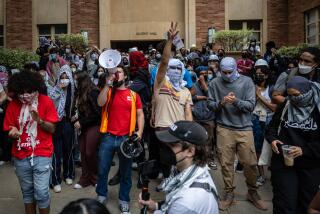The road to Selma: Where do we go from here?
- Share via
The 50th anniversary marches and speeches are over. The celebrities and crowds have gone, and Selma is left to sink back into the neglect that keeps its citizens among the poorest in the nation. So, where do we go from here?
That is a question, not just for the university students and elder mentors with whom I have been traveling on a civil rights pilgrimage through the Deep South. It is a question for the current incarnation of the movement that reached a high-water mark with the 1965 Selma marches and the passage of the Voting Rights Act. And it is a question for every American who claims to love this country.
During the mass meeting held at Selma’s Tabernacle Baptist Church, the question of where to go next was very much on the agenda. Addressing a crowd packed to the back of the balcony and spilling into the basement and out the church doors, the Rev. Martin Luther King Jr.’s daughter, Bernice A. King, made the crucial point that her father did not do all the work nor bring change all by himself. “My father was a leader among leaders,” she said. And just as in the 1960s, grass-roots activism with a sophisticated strategy is essential today.
King quoted her dad, saying, “A movement that moves people is just a revolt; a movement that moves institutions is a revolution.”
A new leader in the civil rights movement, the Rev. William Barber II, president of the North Carolina NAACP, brought the meeting to a climax with his declaration that tea party conservatives and politicians who cut funding for education and food stamps while giving big tax breaks for the wealthy 1% of Americans were not guilty of mere misguided politics. “It’s sin!” he thundered.
“We came to commit ourselves back to the movement,” Barber said. “If those before us were willing to die, then before I’ll be a slave I’ll be buried in my grave!”
During the mass meeting, the election of an African American president was noted as significant, but there was scant praise for the president himself. Up to the last hours before the anniversary events began, local organizers bickered with planners on the national level. Obama’s decision to come to Selma on Saturday instead of Sunday, the day previous march reenactments have been held, meant he was creating a big disruption in a busy program of workshops and seminars that local organizers had planned.
There was no lack of love for the president on Saturday, though. Tens of thousands jammed Selma’s Broad Street and waited as long as six hours to hear him speak. To that mostly black crowd, Obama is their president. There may be more Hawaii than Alabama in his no-drama style, but they see him as one of their own.
After the speech, my wife and I were sitting on a curb, watching the happy crowd stroll toward rows of vendors selling T-shirts and barbecue. We got into a conversation with a man who was also sitting on the street, waiting for his wife to bring some ice cream. The man said he had listened closely to all of Obama’s speeches and thought this one would be remembered in history books.
He could be right, both because of the significance of the day and because the president’s eloquent words went beyond his usual careful conciliation. Obama castigated those who discount the progress that has been made since 1965, calling such gloomy thinking a “disservice to the cause of justice,” but he also forcefully called out those who think that racism and its effects have been eliminated. He said the march for equality, opportunity and a more just society is far from over.
“This is work for all Americans, and not just some,” the president said. “Not just whites. Not just blacks. If we want to honor the courage of those who marched that day, then all of us are called to possess their moral imagination. All of us will need to feel, as they did, the fierce urgency of now. All of us need to recognize, as they did, that change depends on our actions, our attitudes, the things we teach our children.”
On Sunday, with the president’s words still resonating in the streets, lots of important people in fancy clothes made their way to an invitation-only church service at Brown Chapel, an imposing brick building with two high towers that is surrounded by Selma’s housing projects. Andrew Young and Jesse Jackson - who, 50 years ago, were among the young activists battling the old racist system - arrived at the church in motorcades escorted by police. A crowd of a few thousand waited outside Brown Chapel. The patient crowd would eventually follow the dignitaries in the official march to the Edmund Pettus Bridge, where they would bump up against an estimated 50,000 ordinary citizens who had already converged there.
A steady stream of impromptu bridge crossings went on all afternoon. Among the throng was my group of “52 Strong.” We had learned so much from the gracious and brave people we had met during our journey and from one another. One central lesson that I take away from the experience was articulated by a student in our group named Aida Solomon. She had told us about her family emigrating from Ethiopia and how she had difficulty, not only finding her comfort zone in the predominantly white city of Seattle, but in the black community where she was a bit exotic. For a long time, Aida had struggled to define for herself what it means to be an American. She even considered going back to Ethiopia.
But she stayed. As we boarded the bus on the far side of the Edmund Pettus Bridge, Aida split off from the group. She was returning to her internship at the University of Mississippi, where she is engaged in work to end discrimination and promote racial reconciliation. Aida is on the job in that bastion of the Old South because she finally found her American identity. For this young woman whose idealism is as bounteous as her wonderfully extravagant black hair, an American is someone who believes in justice and fights for it.
As definitions go, I cannot think of a better one.
More to Read
A cure for the common opinion
Get thought-provoking perspectives with our weekly newsletter.
You may occasionally receive promotional content from the Los Angeles Times.







